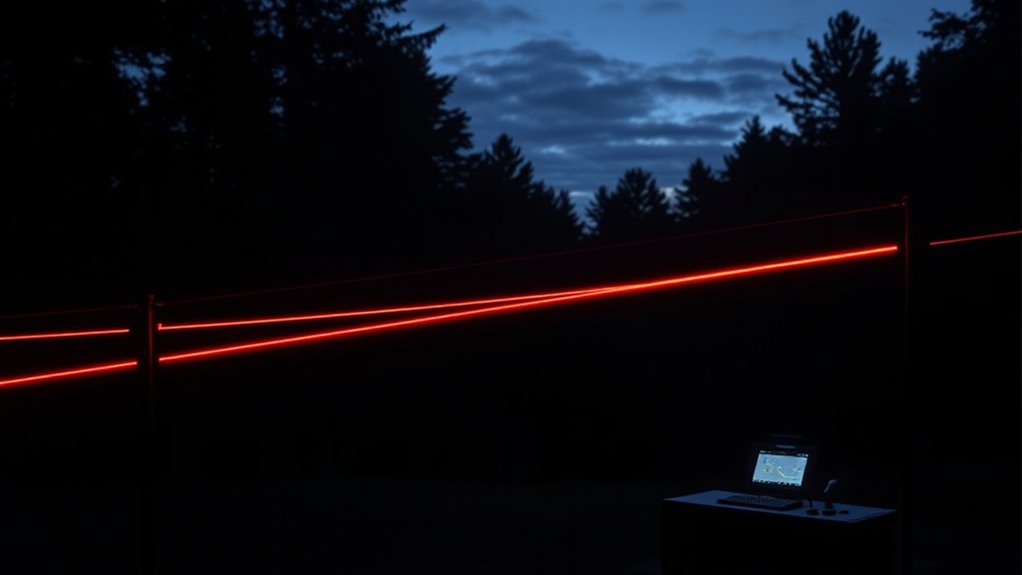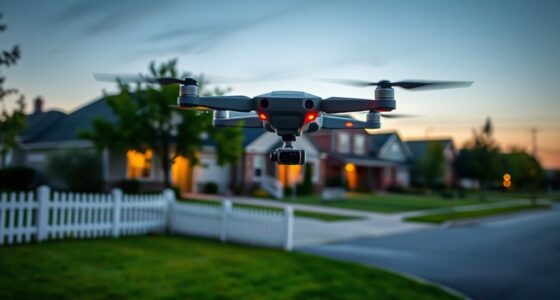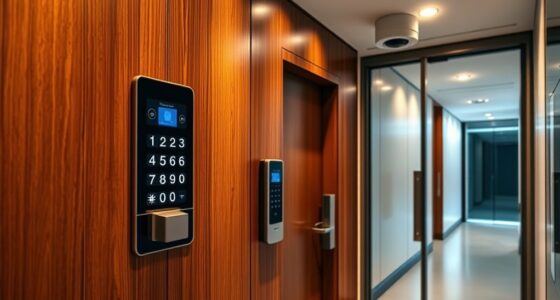Perimeter laser tripwire systems use invisible laser beams to monitor large areas precisely and instantly detect intruders when a beam is interrupted. They consist of laser emitters, detectors, and signal processors that work together to provide reliable security with minimal false alarms. These systems are flexible, scalable, and less intrusive than traditional barriers, making them ideal for protecting property and wildlife. To learn more about how these systems are set up and their benefits, keep exploring the details below.
Key Takeaways
- Perimeter laser tripwire systems use infrared laser beams to detect intrusions by interrupting the beams.
- They consist of laser emitters, detectors, signal processors, power sources, and mounts for stability.
- Proper installation involves precise alignment and regular maintenance to prevent false alarms.
- They offer scalable configurations like single, multi-beam, horizontal, vertical, and dual-layer setups.
- These systems are cost-effective, non-intrusive, environmentally friendly, and can integrate with advanced security technologies.
How Perimeter Laser Tripwire Systems Work

Perimeter laser tripwire systems work by creating an invisible, precise line of laser beams across a designated area. These systems rely on visual detection to monitor movement along the laser path. When an intruder crosses the beam, the system detects the interruption instantly. Infrared technology plays a vital role, enabling the lasers to operate effectively in various lighting conditions and through obstacles like fog or darkness. Unlike traditional security measures, laser tripwires provide high accuracy and minimal false alarms. As soon as the infrared beam is broken, the system triggers an alert, allowing you to respond quickly. This combination of visual detection and infrared technology ensures reliable perimeter security, making it difficult for intruders to bypass the system unnoticed.
Main Components of Laser Tripwire Security Systems
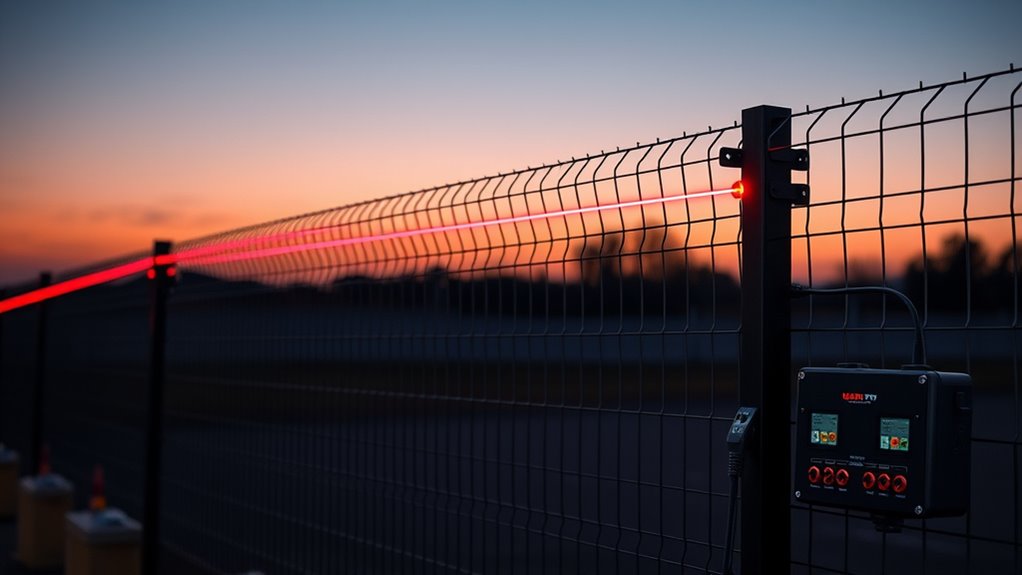
To understand how laser tripwire systems operate, it’s crucial to know their main components. You’ll find laser emitters and detectors, a signal processing unit, and power supplies with mounts working together. These parts ensure the system functions reliably and effectively to secure your perimeter. Understanding regional legal resources can also be beneficial if legal issues arise related to security systems.
Laser Emitters and Detectors
Laser emitters and detectors are the core components that enable laser tripwire security systems to function effectively. The laser emitter produces a focused laser beam that travels across the designated perimeter. This laser beam forms part of a precise sensor array, which detects any interruptions or disruptions. The detector, positioned directly opposite the emitter, continuously monitors the laser beam’s integrity. When someone crosses the beam, the detector senses the break in the sensor array, triggering an alert. These components must be carefully aligned to ensure accuracy and reliability. The laser emitter’s output and the detector’s sensitivity determine how well the system detects intrusions. Proper calibration of these components is essential for optimal performance. Together, they create a non-contact, highly sensitive perimeter security solution, making it difficult for intruders to breach without detection.
Signal Processing Unit
The laser emitters and detectors generate the raw signals that need processing to accurately identify intrusions. Your signal processing unit filters out noise and false alarms through signal filtering, guaranteeing only genuine interruptions are detected. It analyzes the data to distinguish between environmental disturbances and actual intrusions, maintaining system reliability. To protect sensitive information, the unit also encrypts data during transmission and storage using data encryption, preventing unauthorized access. This ensures that intrusion alerts remain secure and tamper-proof. The processing unit acts as the system’s brain, combining filtering, analysis, and encryption to deliver accurate, secure detection. By efficiently managing these tasks, the signal processing unit plays a crucial role in maintaining the system’s effectiveness and integrity.
Power Supply and Mounts
Power supplies and mounts are essential components that guarantee your laser tripwire system operates reliably and remains properly aligned. They assure your sensors stay powered and functioning, even in remote locations. Solar panels provide sustainable energy, reducing reliance on grid power, while backup batteries keep your system active during outages. Proper mounts secure the lasers firmly, maintaining precise alignment and consistent detection. Without reliable power and sturdy mounts, your system’s effectiveness drops dramatically. Utilizing high-quality mounts ensures long-term stability and accuracy of your system.
Advantages of Using Laser Tripwires for Property Protection

Because they can detect intruders instantly, laser tripwires offer a highly reliable method for protecting your property. They provide cost-effective solutions by reducing the need for frequent patrols and manual monitoring, saving you money over time. Laser tripwires also enhance safety by minimizing false alarms and ensuring quick responses to genuine threats. Their precise detection capabilities mean you can cover large areas without multiple devices, making them an efficient security option. Additionally, laser systems are less intrusive and harder for intruders to bypass compared to traditional barriers. This combination of affordability, reliability, and safety makes laser tripwires an excellent choice for maintaining perimeter security and deterring potential intruders effectively. Incorporating security practices such as proper placement and regular maintenance can further optimize their performance.
Setting Up and Maintaining Laser Tripwire Systems
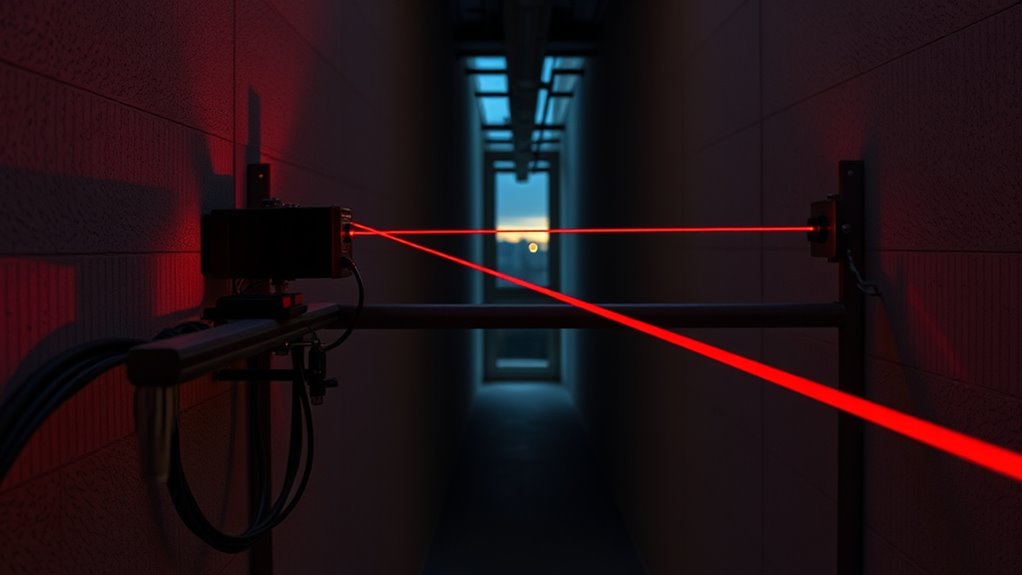
To guarantee your laser tripwire system works reliably, you need to focus on precise alignment techniques. Regular inspections help catch any misalignments or issues before they compromise security. By staying proactive, you keep your system functioning at peak performance. Additionally, ensure that the system components are properly maintained, such as cleaning lenses and checking power sources.
Precise Alignment Techniques
Achieving precise alignment is essential for the effective operation of laser tripwire systems. To do this, you must carefully perform calibration procedures using reliable alignment tools. Proper setup ensures the laser beam stays focused and aligned, preventing false alarms or blind spots. Use laser levels, target cards, and reflective surfaces to fine-tune the system. Keep these critical factors in mind:
- Feel the confidence that comes with flawless calibration
- Experience peace knowing your perimeter is secure
- Avoid costly false alarms caused by misalignment
- Trust in your ability to maintain peak system performance
- Protect your assets with unwavering accuracy
Mastering alignment techniques guarantees your laser tripwire system operates flawlessly, providing peace of mind and unmatched security. Regularly monitoring and adjusting your system in response to environmental changes is also crucial to maintaining its optimal performance.
Regular System Inspections
Once your laser tripwire system is properly aligned, regular inspections become essential to maintain its peak performance. Frequent checks ensure the system’s intruder detection capabilities remain reliable and effective. During inspections, verify the laser alignment and test the sensors to confirm they respond accurately to any movement. Regular calibration is vital to prevent false alarms and ensure consistent performance over time. Look for dust, debris, or obstructions that could interfere with the laser beam, and clean the components as needed. If you notice any misalignment or irregularities, recalibrate the system immediately. Maintaining a routine inspection schedule guarantees your laser tripwire system stays sensitive to intruders, reducing the risk of breaches and ensuring your perimeter security remains robust. Incorporating system diagnostics can help identify potential issues before they compromise security.
Common Types of Laser Tripwire Configurations
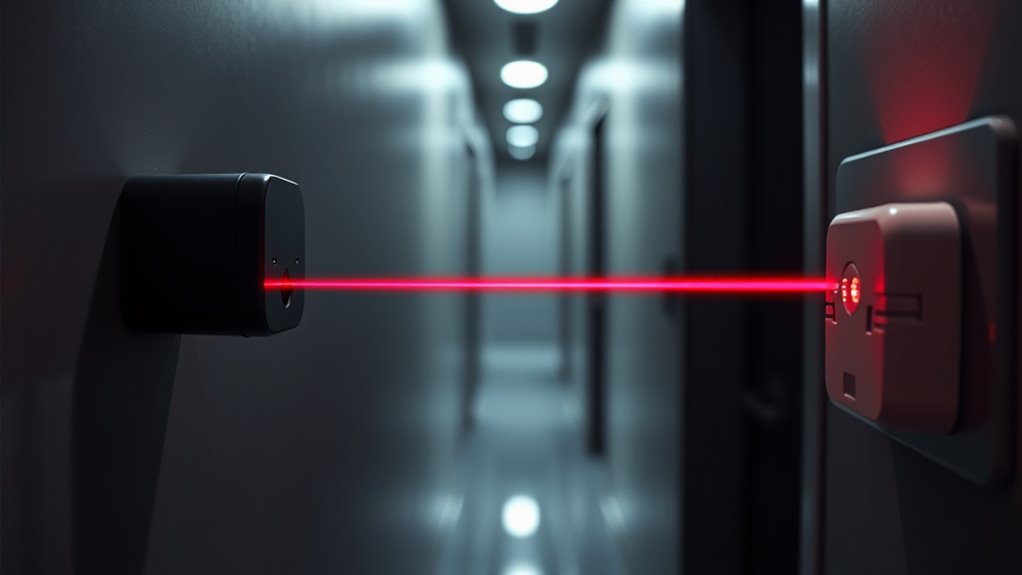
There are several common configurations for laser tripwire systems, each designed to suit different security needs and environments. These setups enhance intruder detection and wildlife monitoring by matching the terrain and threat level.
Various laser tripwire configurations optimize security and wildlife monitoring for different terrains and threats.
- Single beam setups for straightforward perimeter protection, alerting you when breached.
- Multi-beam arrays create a grid, increasing accuracy and reducing false alarms.
- Horizontal configurations cover wide, open spaces, perfect for large outdoor areas.
- Vertical arrangements detect movement across different heights, ideal for wildlife monitoring.
- Dual-layer systems combine multiple beams, providing redundancy and heightened security.
Choosing the right setup guarantees you catch intruders early and monitor wildlife effectively, creating peace of mind and safeguarding your property. Additionally, understanding the effectiveness of different configurations can help you optimize your security system for specific scenarios.
Comparing Laser Tripwires to Traditional Security Barriers
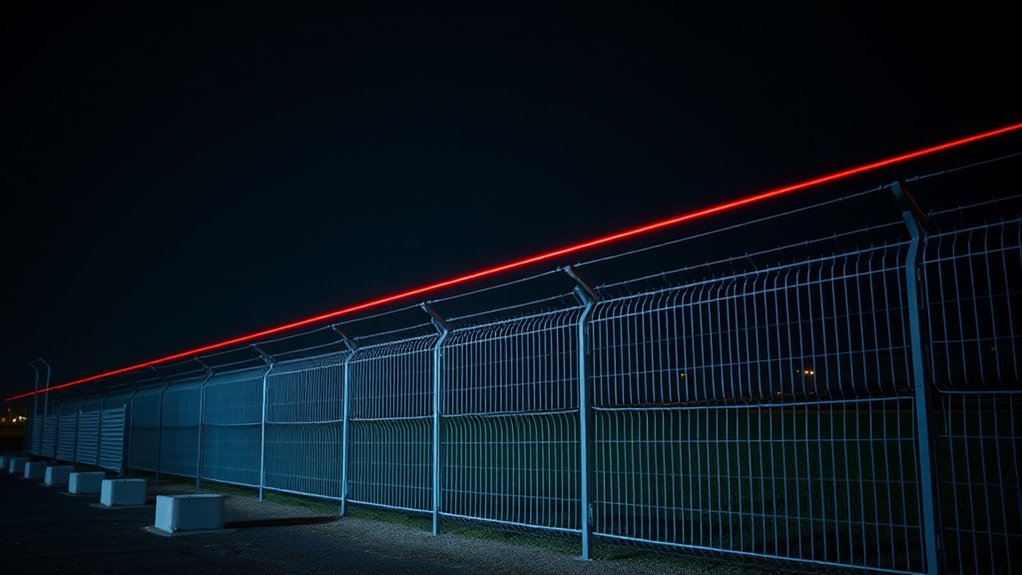
Laser tripwires offer a modern, non-invasive alternative to traditional security barriers like fences, walls, and physical gates. Unlike these physical barriers, laser systems can be seamlessly integrated with wireless networks, allowing remote monitoring and instant alerts. They require minimal physical space, reducing environmental impact and preserving natural surroundings. Environmental considerations are essential; laser tripwires don’t interfere with wildlife or landscape, unlike fences that can trap animals or obstruct movement. They also eliminate the need for ongoing maintenance like repairs or replacements common with physical barriers. Additionally, vibrational energy detection can enhance the system’s sensitivity to unauthorized movements. Overall, laser tripwires provide a flexible, scalable, and eco-friendly security solution that adapts to different terrains and security needs, making them a superior choice for modern perimeter protection.
Future Trends and Innovations in Laser-Based Perimeter Security
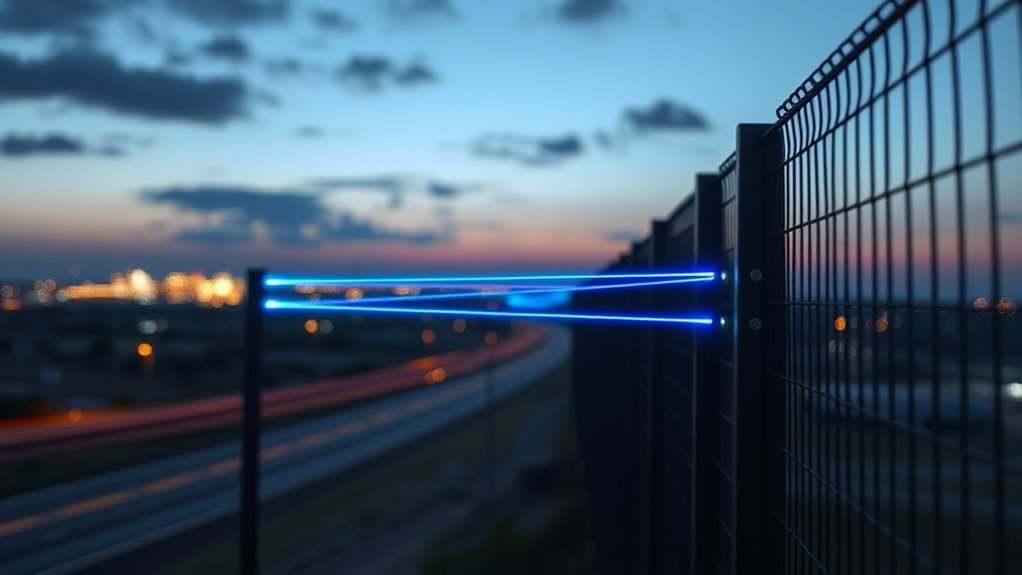
As technology advances, laser-based perimeter security systems are poised to become more intelligent and adaptive. Future innovations include integration with AI threat detection, enabling systems to distinguish between real threats and false alarms. Autonomous drones will patrol perimeters, responding instantly to breaches detected by laser tripwires. You’ll benefit from smarter alerts, reducing unnecessary disruptions. Imagine a security network that adapts to new threats without manual updates. Enhanced sensors will provide real-time data, improving response times dramatically. Here’s what you can expect:
- Increased accuracy with AI-driven threat analysis
- Autonomous drones covering large or complex areas
- Adaptive systems that learn from past breaches
- Seamless integration with existing security infrastructure
- Greater overall security and peace of mind
These innovations will redefine perimeter protection, making it more reliable and proactive. Exploring emotional support strategies can also help in managing the stresses associated with security concerns and technological changes.
Frequently Asked Questions
What Is the Typical Range of Laser Tripwire Systems?
You might wonder about the typical range of laser tripwire systems. Generally, these systems offer a laser accuracy that spans from 10 meters up to 300 meters, depending on the model. Proper system calibration is essential to maintain peak performance over this range. The actual distance you can cover depends on factors like laser power, atmospheric conditions, and the environment, so calibration helps ensure reliable detection across the intended span.
How Do Laser Tripwires Perform in Adverse Weather Conditions?
You might wonder how laser tripwires perform in adverse weather conditions. Their weather resilience varies; heavy rain, fog, or snow can weaken signal strength and cause potential false alarms. Additionally, weather-related factors may lead to signal interference, reducing detection accuracy. To guarantee reliable security, it’s crucial to choose systems designed with weather-resistant features and to regularly maintain and calibrate the equipment for peak performance.
Are Laser Tripwire Systems Suitable for Large or Complex Perimeter Setups?
Laser tripwire systems can be suitable for large or complex perimeter setups, but you should consider their limitations. You might face laser system limitations, such as reduced effectiveness over long distances or in complicated terrain. Installation challenges can also arise, especially in extensive areas where precise alignment is vital. To guarantee peak performance, plan carefully, account for potential obstacles, and consider supplemental security measures to address these challenges effectively.
What Maintenance Is Required to Ensure System Reliability?
Imagine your system as a vigilant guardian, needing gentle tune-ups to stay sharp. You should regularly perform calibration procedures to guarantee the laser beams stay precise, and fault diagnostics to spot any hidden issues early. Keep lenses and sensors clean, and check alignment periodically. This routine maintenance helps your perimeter laser tripwire system remain reliable, providing peace of mind that your security remains unwavering, no matter the challenge.
How Do Laser Tripwires Integrate With Existing Security Systems?
When you integrate laser tripwires with existing security systems, you often face integration challenges and system compatibility issues. You’ll need to verify that the laser sensors communicate seamlessly with your alarm panels or monitoring software. This may involve configuring interfaces or updating firmware. By addressing these challenges early, you guarantee your laser tripwire system works smoothly alongside your current security setup, enhancing overall protection without disruptions.
Conclusion
Laser tripwire systems are revolutionizing perimeter security, offering a reliable alternative to traditional barriers. With over 60% of break-ins involving some form of perimeter breach, using laser tripwires can greatly reduce vulnerabilities. They’re easy to set up and maintain, providing 24/7 protection. As technology advances, expect even smarter, more integrated systems that make your property safer and more secure. Embrace laser security now to stay ahead of potential threats and assure peace of mind.
